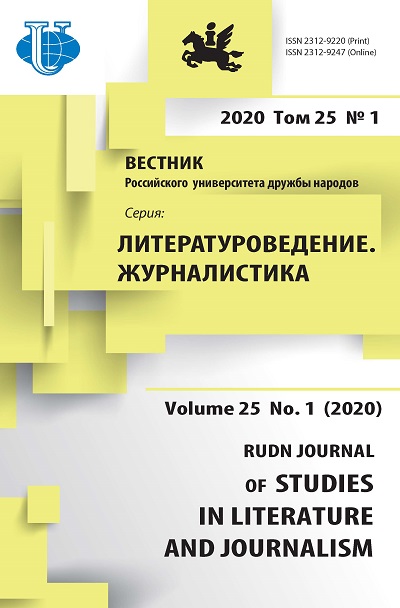Indian social media politics: new era of election war
- Authors: Patel K.1, Binjola H.2, Siddiqui T.2
-
Affiliations:
- Mahatma Gandhi Chitrakoot Gramoday University
- Graphic Era Hill University
- Issue: Vol 25, No 1 (2020)
- Pages: 184-192
- Section: JOURNALISM
- URL: https://journals.rudn.ru/literary-criticism/article/view/23621
- DOI: https://doi.org/10.22363/2312-9220-2020-25-1-184-192
- ID: 23621
Cite item
Full Text
Abstract
Keywords
About the authors
Keshav Patel
Mahatma Gandhi Chitrakoot Gramoday University
Email: mgcgv@rediffmail.com
researcher (academic), Department of Communication Kamtan, Janki Kund, Chitrakoot, Madhya Pradesh, 485334, Republic of India
Himani Binjola
Graphic Era Hill University
Email: enquiry@gehu.ac.in
Assistant Professor, Department of Media & Mass Communication 566/6 Bell Road, Society Area, Clement Town, Dehradun, Uttarakhand, 248002, Republic of India
Taha Siddiqui
Graphic Era Hill University
Email: enquiry@gehu.ac.in
Assistant Professor, Department of Media & Mass Communication 566/6 Bell Road, Society Area, Clement Town, Dehradun, Uttarakhand, 248002, Republic of India
References
- Patel, K. (2015). Social Media in the Indian Context: New Flavor of the Season. Global Journal of Multidisciplinary Studies, 4(6), 268-270.
- Biswas, A., Ingle, N., & Roy, M. (2014). Influence of Social Media on Voting Behavior. Journal of Power, Politics & Governance, 2(2), 127-155.
- Patel, K. (2018, November). Impact of Advancements in Technological Aids in Communication Media in Bringing About Social Reformation. Global Conference on Journalism and Mass Communication, Colombo, Sri Lanka.
- Nayak, D. (2019, 8 March). Internet Users In India Exceeds Half A Billion People In 2018, 97% Use Mobile To Connect. Dazeinfo. https://dazeinfo.com/2019/03/08/indiaInternet-users-2018-mobile-report/ (accessed: 12.09.2019).
- West, A. (2010). Advertising 2.0: social media marketing in a Web 2.0 world. Routledge Journals, Taylor & Francis Ltd.
- Patel, K. (2017). Lok Sabha 2014, Narendra Modi and Social Sites. International Journal of Recent Advances in Psychology & Psychotherapy, 1(1), 24-28.
- Akrimi, Y., & Khemakhem, R. (2012). What drive consumers to spread the word in social media? Journal of Marketing Research & Case Studies, (1), 1-14.
- Tumasjan, A., Sprenger, T.O., Sandner, P.G., & Welpe, I.M. (2010). Predicting elections with twitter: What 140 characters reveal about political sentiment (pp. 178-185). Fourth International AAAI Conference on Weblogs and Social Media.
- Chaffee, S.H., & Kanihan, S.F. (1997). Learning about Politics from the Mass Media. Political Communication, 14(4), 421-430. doi: 10.1080/105846097199218.
- Wallsten, K. (2007). Agenda setting and the blogosphere: An analysis of the relationship between mainstream media and political blogs. Review of policy Research, 24(6), 567-587.
- Sauter, T., & Bruns, A. (2013). Social Media in the Media: How Australian Media Perceive Social Media as Political Tools. ARC Centre of Excellence for Creative Industries and Innovation, Brisbane, Queensland, Australia.
- Williams, A., Guglietti, M.V., & Haney, S. (2018). Journalism students’ professional identity in the making: Implications for education and practice. Journalism, 19(6), 820-836.
- Express Computer. (2018, 5 December). India To Have Over 800 Million Smartphone Users By 2022: Cisco. Retrieved from https://www.expresscomputer.in/Internet/indiato-have-over-800-million-smartphone-users-by-2022-cisco/30512/ (accessed: 20.12.2019).
- Li, R., & Suh, A. (2015). Factors influencing information credibility on social media platforms: Evidence from Facebook pages. Procedia computer science, 72, 314-328.
- Allcott, H., & Gentzkow, M. (2017). Social media and fake news in the 2016 election. Journal of economic perspectives, 31(2), 211-236.
- Golan, G., & Wanta, W. (2001). Second-level agenda setting in the New Hampshire primary: A comparison of coverage in three newspapers and public perceptions of candidates. Journalism & Mass Communication Quarterly, 78(2), 247-259.
Supplementary files















